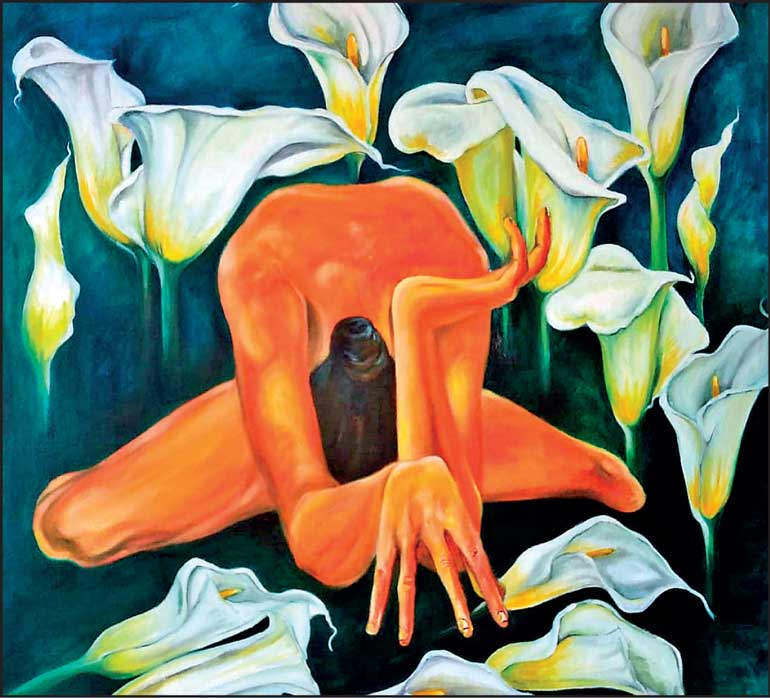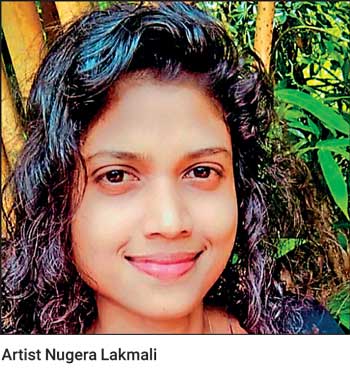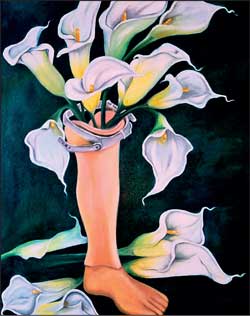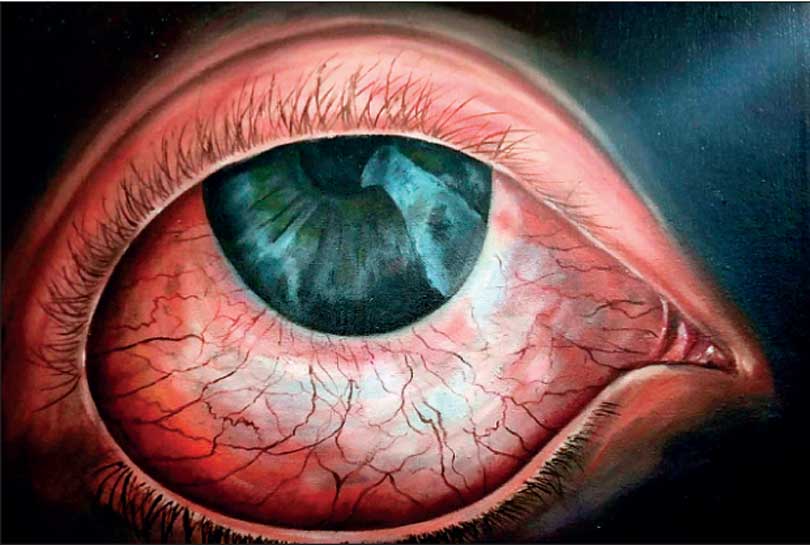Wednesday Dec 10, 2025
Wednesday Dec 10, 2025
Saturday, 15 July 2023 00:10 - - {{hitsCtrl.values.hits}}

The physical atmosphere that we create for ourselves in our houses and surrounding and thus the nation will speak volumes about our mental state. If we fill our minds freely with garbage as we do our surroundings and our land – then obviously our consciousness is blocked with rubbish as we fill our minds mechanically with ‘education’ and our purses with money
 By Surya Vishwa
By Surya Vishwa
If life is an art why are we not living the art? Between the canvas of birth and death are we earning a life or a drudgery? Are we earning happiness or sorrow? Are we earning freedom or imprisonment?
These above questions are asked within the topic of this article which was chosen based on a series of conversations that took place as part of this writer’s formal and informal interactions in the past week.
One of the formal interactions was with Sarath Perera, Senior Lecturer of the Department of Painting, Faculty of Visual Arts, University of Visual and Performing Arts and former Dean of the Faculty of Visual Arts. A meeting was scheduled to discuss a youth based interaction the Harmony page is initiating to commemorate International Friendship Day. The first informal interaction was with one student of his. We begin with this and then at the end of this narration what is featured is an interaction outside the art circuit.
In the discussion that ensued and in observing the milling about of students and their manner within the premises of the University of Visual and Performing Arts, it was evident that the usual rote learning stress one sees in solely academic centred universities was not evident here in this atmosphere.
There was a carefree vibe that one instantly caught onto – the students themselves – the manner in which they interacted, walked and their very persona and dress code showed a particular freedom that is absent in a world that is busy dying in pursuing what they think is making a living.
At the time of my visit to this university the students had just finished their art projects as part of their final exams and those in far flung regions of the country were leaving for their homes.
As I was walking out of the campus premises there was a lorry stacked with colourful canvasses of diverse sizes. A few students were there loading the canvases. I meandered over and tried to get a glimpse of the art. As I shifted a few paintings there were different themes as was self-evident.
One painting that caught my eye in particular was a painting of a woman where at first glance one could not really notice anything amiss – but on close inspection it was obvious that one of her legs were missing – she was in a head lowered yoga type position with lily flowers around her. The other rather startling image was that of a leg where instead of the flesh there were lily flowers around and inside the contraption one fixes as an artificial leg.
Next I picked up a smaller canvas with the image of a human eye painted with the perfect chiaroscuro of a live eye, with the thin ripple of red veins running through as it would after a wave of sleeplessness that we drown in sometimes.
 As I was staring mesmerised by these images, their creator emerged; young Nugera Lakmali. Chatting with her I learnt the story of the birth of the above described three paintings. They were part of her graduation art project as were the scores of other paintings loaded into the lorry. They were to be transported to Dambadeniya, her hometown where she was planning to set up her own art gallery. Her mother and aunty had come to Colombo to witness the work of their daughter being displayed and were helping to fit the canvases into the vehicle to ensure the paintings were not damaged.
As I was staring mesmerised by these images, their creator emerged; young Nugera Lakmali. Chatting with her I learnt the story of the birth of the above described three paintings. They were part of her graduation art project as were the scores of other paintings loaded into the lorry. They were to be transported to Dambadeniya, her hometown where she was planning to set up her own art gallery. Her mother and aunty had come to Colombo to witness the work of their daughter being displayed and were helping to fit the canvases into the vehicle to ensure the paintings were not damaged.
Nugera first shared with me how the inspiration emanated for the lily flowers represented painting.
“I saw this contraption as one would a bouquet of lily flowers”
“There is a lady of about 35 years in my village who does not have one leg and depends on the artificial leg that she straps on every day. As she is still a young woman she dreams of finding perfect love – that she would be loved for herself – and to appear as she sees others around her the artificial leg is to her the flowering gift,” the young Nugera explained.
“So I saw this contraption as one would a bouquet of lily flowers – her hope and her dream,” she said.
As she spoke, her very nature, the sensitivity in her – as bestowed by nature to anyone – whether artist or not – who has awakened to the humanity in them and others, was palpable.
The young artist continued the story of her art.
“As I listened and observed this young woman in my village, I lived her dreams and what went on in her inner mind. As I began to internalise those thoughts and aspirations, in my artistic metamorphosis I became her and I painted from that standpoint,” pointed out Nugera.
Her mother and aunty standing close by, obviously proud of their child, listened silently, smiling in appreciation.
Nugera then went on to explain the story behind the smaller canvass – the one of the human eye with the filigree veins.
“The images that run through my mind often activate themselves throughout the night and I find it hard to sleep. Keeping to the daily schedule at times makes it very challenging for me and results in stress. So I painted the eye as it was when I woke up with poor sleep,” she explained.
Art and knowledge are both the visual clay. The beholder moulds for herself or himself the image of what she or he wants to create as per the individualistic worldview.

Hence when I first looked at the visual of the eye, I interpreted it as how the iris of each human being’s eye is a symbol of a particular lens that the person concerned sees this universe. Thus for me the iris and pupil of the eye were the components of the camera of each person’s visual domain which colour how they see this world and all in it – plants, animals, rivers, seas, mountains, deserts, sky, sun, moon, stars and humans. At the beginning of this article it was mentioned that the theme as mentioned in the headline and the opening lines were based on differing informal interactions.
The second informal interaction is as follows;
Having accepted a dinner invitation from a neighbour, an accountant with two bright children interested very much in experimenting with different forms of knowledge and who had a very interesting grandmother who supported them and was into learning different things herself, I was listening to the lady accountant in a key State institution describe how unhappy her office atmosphere is.
Everyone is utterly unhappy
“Isn’t there anyone who is happy there,” I asked rather casually.
“No. Not one bit. Everyone is utterly unhappy. They are unhappy in the office. They are unhappy at home,” revealed this young woman who was in her late thirties. Her family atmosphere was a very supportive and happy one and she revealed how she waits for 4 p.m. to begin planning the homeward journey.
The reasons for the unhappiness at office were listed as follows; petty envies, comparing each other and seeing the other as more privileged in circumstances and in office performance, overload of work, difficulty in making ends meet, stress of education of children, peer pressure of children. This last factor impacts parents who send their children to elite schools and then have to keep up with the child asking for that which he sees others having – expensive phones, toys, fast food, etc.
As I continued to listen to her and her plans of leaving her office job and set up her own accounting consultancy firm from her home, I described to her how happy the young artists that I saw at the Faculty of Visual Arts were. Their lives too may be replete with financial hardships as most of them were from remote areas and living in a country where stupidity reigns and being an artist is not ‘recognised’ by most parents.
This is a nation where parents think that there are only three professions worth following – western medicine, law or engineering – and that too with zero innovation – merely for prestige. Thus we produce young people who go on route to practice these professions. Money making and prestige are often the only aim (mostly of the parents) and the children soon become the prototype of this blind fervour. The money of course is finally at some point in life sacrificed at brick made edifices called hospitals.
“I don’t want to live like that,” quipped the 16-year-old daughter as she revealed that she gets very high marks for physics and mathematics. She enjoys reading cookbooks from different countries and experimenting and says she wants to be an internationally recognised ‘art cook’! The last phase is of course influenced by the narration of the young artist. It was noticeable that neither the mother nor grandmother vilified the suggestion but instead suggested that she does some artistic cooking at my house! Thankfully the conversation shifted to food thereon and the misery that people bring upon themselves no longer polluted the lovely time with this family.
Are we earning a healthy living or a premature, sick and paltry dying?
So to end where we began – are we earning a healthy living or earning a premature, sick and paltry dying – without realising the significance of each human life? If the philosophy of the Buddhist and Hindu teachings were to be taken into account then how we live as a society is entirely outside the parameters of this knowledge. Hinduism and Buddhism hold that to be granted a human life is a major boon based on our collective actions in each lifetime (Karma).
It is not the intention to take this analysis on religious lines and hence looking from a basic common sense dimension we will understand – if we exercise our minds to think – that we have a journey to tread between life and death and that this path has to be productive holistically beyond getting a whole bunch of coloured paper called money. We ask the reader who has read so far – to walk around the roads of Colombo. When you walk would you feel happy. Obviously not. There are potholes filled with rainwater and plastic and garbage strewn around freely. The physical atmosphere that we create for ourselves in our houses and surrounding and thus the nation will speak volumes about our mental state. If we fill our minds freely with garbage as we do our surroundings and our land – then obviously our consciousness is blocked with rubbish as we fill our minds mechanically with ‘education’ and our purses with money.
The intention of the media innovation that the Harmony page is, is to encourage thinking and reflection to bring about holistic change in society by each of us being the change we want to see. Thus we hope that this article has contributed somewhat to this objective.